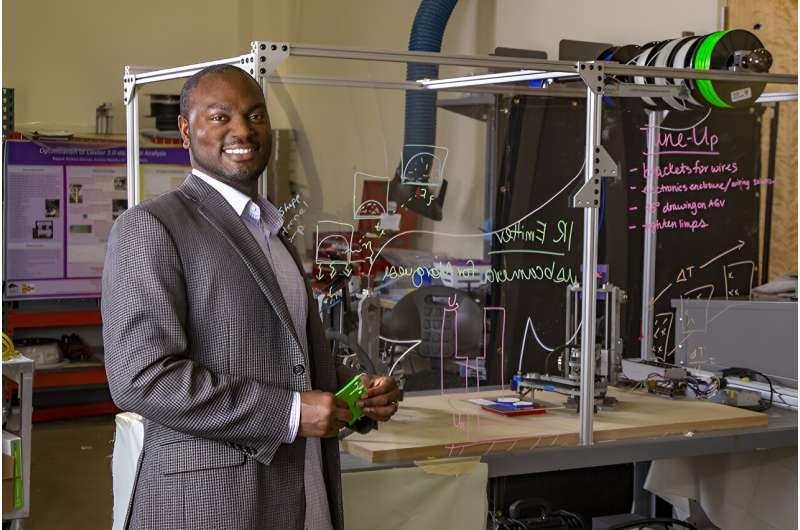
In everything from electronics in cars to the components of commercial airliners are state-of-the-art 3D-printed materials. Their strength and properties depend on what they're made of and how they're made.
Inside Tarik Dickens' lab at the FAMU-FSU College of Engineering, researchers are fine-tuning the tools used in 3D printing, helping to create better, stronger materials for a wide variety of applications.
"We're about to cross the threshold of the first quarter of the 21st century, and we're going to need a lot more personalized products and structures and the ability to be able to create structure and devices on the fly," Dickens said.
"It's not going to be like the previous 60 years of industrialized research where you're experimenting with something for multiple years. You need to be able to have an initial idea of something and then have the prototype and the end product in one."
3D printing, also called additive manufacturing, makes that possible.
Dickens started his research career developing multifunctional composite materials, which are made of two or more substances combined to create a new material with added functionality.
Examples range from simple combinations, such as reinforced concrete or plywood, to state-of-the-art ceramic composites used in jet engines. By combining multiple substances in novel ways, scientists can create new materials with specially selected properties of interest.
Additive and digital manufacturing offer new ways to develop composite materials, which is now the focus of Dickens' research.
For example, some 3D printed plastics have small pieces of metal inside. Dickens developed a small magnetic device that can rotate nanoparticles within fluid suspensions during 3D printing to adjust properties such as strength—research that is part of the National Science Foundation's Centers of Research Excellence in Science and Technology Center program.
His group has a patent on this device setup and is working on other assisted-printing apparatuses.
"The goal is to make what we call multimaterial and multifunctional structures commonplace in additive processing," he said. "These multifunctional structures have different applications and endpoints.
"For these materials, it was about embedding some dielectric properties and capabilities to enable electromagnetic shielding and interference. They also can have structural applications to actually strengthen the structure that you're trying to create."
A paper by Dickens, graduate student Abdullah Al Noman and postdoctoral researcher Balaji Krishna Kumar published last year in Virtual and Physical Prototyping examined the state of additive manufacturing and the emerging technique of field-assisted additive manufacturing, which uses things like magnets, acoustics or electricity to fine-tune printing.
By using magnetic nanomaterial combined with a nonmagnetic material, printers can create a composite with fibers oriented in a certain direction, allowing for a final product with specific strength properties. The research team examined different combinations of wire or powder as printing material, finding the ratio that yielded maximum strength and flexibility.
3D printing research, like the techniques being developed by Dickens, could be used to create custom models or rapid prototypes for a wide variety of applications. As additive manufacturing continues to develop, engineers are working to make the technology more available.
"What if you could wake up every morning and have a new car?" Dickens said. "I'm a car lover. I would love to wake up and drive a Ferrari one day and a Maserati the next. In that sense, one future direction for additive manufacturing is like the computer itself. We now have computers in every household. If you had a 3D printer in every household, that would be like technology out of 'Star Trek.'"
More information: Abdullah Al Noman et al, Field assisted additive manufacturing for polymers and metals: materials and methods, Virtual and Physical Prototyping (2023). DOI: 10.1080/17452759.2023.2256707
Citation: Engineers develop new 3D printing technology (2024, May 14) retrieved 14 May 2024 from https://techxplore.com/news/2024-05-3d-technology.html
This document is subject to copyright. Apart from any fair dealing for the purpose of private study or research, no part may be reproduced without the written permission. The content is provided for information purposes only.
